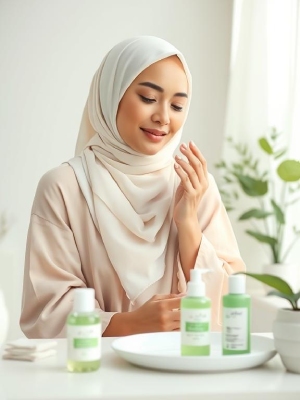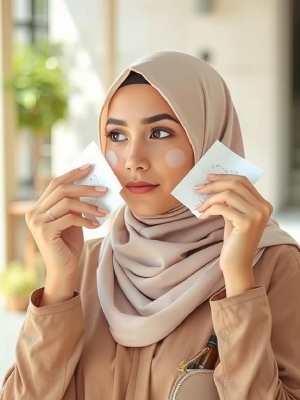
The wearing of a hijab can be empowering, beautiful, and part of one’s identity; on the other hand, it can also come with certain unique challenges in caring for the skin, especially when dealing with oily skin. When the top-most layer of the skin is oily, having pimples can irritate the fabric-and-once in a while, it may seem like a fine balancing act to care for one’s skin and indulge in modest fashion. But hold on! With the rocking skincare routine in place for your skin, you can keep your skin shining and fresh all day long.
Oily Skin Under the Hijab
Before starting a skincare routine, it’s important to think about why oily skin may be behaving differently while you are wearing the hijab. The heat, humidity, and tighness of the hijab may cause higher oil production, especially around the forehead, nose, and chin areas, whether you call it the T-zone or not. Excess oil clogs the pores which may lead to acne and this, in turn, can cause irritation.
Helping find the right ingredients and routines to keep the oil balanced and skin clear, with protection against fabric friction and occlusion, has been one big challenge for hijabis. However, given the right angle, you can solve this whole scenario.
Basic Skincare Steps for Oily Skin
A perfect treatment for oily skin focuses on keeping oil at bay, moisturizing, anti-breakouts, and shielding the skin against impurity and scar days. Following is a guideline to follow a skincare routine for hijabis who have oily skin:
The Starting Point: Gentle Cleanser
If you have oily skin, the primary goal for the cleanser is to remove excess oil without making the skin lose its natural moisture. Abrasive cleansing or exfoliation dries out the upper layer of the skin. To counter the drying effect, the sebaceous glands may secrete even more oil into the skin surface, worsening the situation. Select:
- Gel-type or foam-type cleansers
- Salicylic acid or tea tree oil that boasts deep cleansing attributes
- Products acetate-free to prevent drying of your skin
After cleansing in the morning, cleanse again at night. Take the cleanser between your fingers and rub for about 30 seconds, focusing on the T-zone. Do not scrub vigorously since it irritates the skin and increases oil production.
Exfoliate Weekly
A good exfoliation sweeps away dead skin that clogs pores and causes acne. This is more relevant to oily skin as it keeps those pores clear and augments relief from blackheads and whiteheads. Look for:
- A mild exfoliator with salicylic acid (BHA) or glycolic acid (AHA)
- Exfoliating with genuine products that have small, gentle particles or with liquid exfoliants that do not damage the skin
Exfoliate one to two times a week, but never more. Over-exfoliating can cause skin irritation and dry it out, and in response, your skin will produce more oil to protect itself.
Tone for Balance
A good toner helps to balance the pH of your skin and tighten the pores while washing off any remaining traces of dirt or makeup. If your skin is oily, it will regulate the amount of sebum produced so that it is never drying. Look for:
- Alcohol-free (to avoid dryness)
- Witch hazel, rose water, or niacinamide as major ingredients
- Hydrating toners that provide balanced moisture
Apply the toner following the cleansing process. Pour the toner onto a cotton pad and sweep it gently across the face with particular attention to the T-zone. Another way is pressing it softly into the skin using your palms for absorption.
Use a Lightweight Moisturizer
Even oily skin demands moisture! Noting moisturizer can shock your complexion into making more oil. Try to use a light, non-comedogenic moisturizer that does not clog-up pores. Look for:
- Gel-based moisturizers that are oil-free;
- Moisturizers with hyaluronic acid-type ingredients that hydrate but do not impart any oiliness;
- Non-comedogenic formulas (especially if you are acne prone).
After toning, applying moisturizer is a must; do not skip! Then, apply a very thin layer of moisturizer all over your face and neck. Make sure it is fully absorbed before going to the next step.
Sunscreen Is a Must for You
The use of sunscreen becomes even more important for oily skin types. This is because UV rays can wreak havoc upon your skin, causing pre-mature aging and even enhancing the formation of hyper-pigmentations from acne scars. Opt products from the list below:
- Oil-free or matte finish sunscreens
- Non-comedogenic formulations
- Sunscreens of SPF 30 or above
Sunscreen application is a must every day, even if you are indoors. Make sure to go ahead and do it as the last step in your skincare routine; then again, this rule transpired for makeup application if you choose to wear the latter. The product must be reapplied every two hours if outdoors.
Watch Out for Spot Treatment
If pimples or breakouts can happen, you have to chase them properly and quickly without disturbing and irritating more skin. Spot treatments can help treat those areas while keeping the rest of the skin away from unwanted intervention. Look for:
- Benzoyl peroxide or salicylic acid for acne
- Tea tree oil or sulphur-based spot treatment
After moisturizing, apply a little spot treatment directly onto the blemishes before sunscreen and makeup application. Do not over-apply, as this may irritate the skin.
Additional Tips
Consider some lifestyle changes for glowing, healthy skin in conjunction with a good skincare regimen.
Ensure the Hygiene of the Hijab
Sweat, oils, and dirt can get trapped in your hijab and irritate the skin, causing breakouts. So keep your hijab clean to prevent these contaminants from lingering.
If you wear a hijab every day, try to wash it every 3 to 4 wears, depending on the type of fabric and its absorbency.
Avoid Tight-Fitting Hijabs
Too much tightness of a hijab can rub anyone into deep unfamiliar feelings of irritation and even enable acne formation along the hairline and forehead. A comfortable, breathable fabric should be chosen and the hijab should never be tied too tightly.
Opt for Breathable Fabrics
Fabrics such as cotton or silk maintain the breathability of the scalp and skin, thereby decreasing any chance of excessive sweating. If your choice is a synthetic, go for a lighter weave that lets less heat build up.
Stay Hydrated
Drinking plenty of water throughout the day helps to maintain good skin from inside. It flushes out toxins, shrinks pores, and plumps them up so they glow with good health.
How to Manage Oily Skin While Wearing a Hijab

Basically, donning a hijab can affect the way skin reacts throughout the day, especially oily skin. The fabric touching your scalp and face can accumulate sweat, oils, and dirt that clog pores and cause breakouts. Here is how you can deal with these more effectively:
Go for Hijab Materials That Are Suitable
Some fabrics tend to hold more sweat or oils than others. Polyester and nylon, for example, are less breathable than natural fibers, thus your skin gets more prone to oiliness as it struggles to regulate its temperature. So keep it natural with cotton, silk, or bamboo to let your skin breathe and prevent the buildup of oils and sweat.
Tip: Lighter-colored hijabs tend not to absorb too much heat compared to darker-colored ones.
Let the Skin Breathe
If your hijab-wearing hours are lengthy, you must grab a short breather for your skin to breathe. If any such intervals are made during the day, let the skin air out. If it is indoors, or in a cool environment, consider loosening the hijab during breaks to cool down your scalp.
Tip: An under scarf or cap that is breathable can be used in combination with the hijab to minimize the amount of fabric directly hitting the skin.
Use Oil-Absorbing Sheets During the Day
Carrying oily skin makes it a must to curb shine during the day while being under the hijab for hours. Oil-absorbing sheets suit well to blot out excess oil without disturbing makeup or skincare.
Tip: Tuck a few blotting tissues in your bag to refresh your skin anytime, some points worthy of special care being the forehead, nose, and chin.
Wear a Headband or Scalp Protector
Prying your scalp perspiration out and misting his very light headband can take oil and sweat on your scalp. This also stops the oil from migrating onto your hijab, thereby keeping it cleaner and fresher for much longer.
The Hijabi Glow-Up
Caring for an oily skin of a hijabi requires a thoughtful treatment that incorporates the physical challenges with wearing a hijab and the peculiar needs of your skin. By thoroughly cleansing your skin, exfoliating periodically, applying moisturizers, and using sunblock, your skin will maintain its crystal clearness and health anytime in the day throughout

